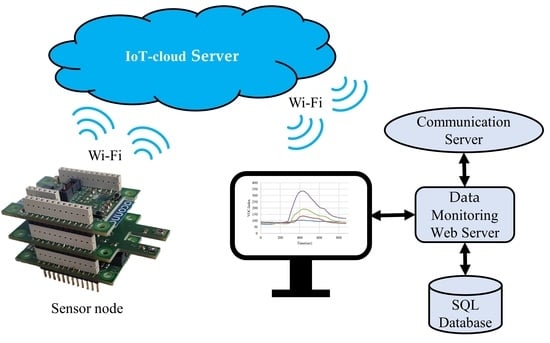Evaluating a Novel Gas Sensor for Ambient Monitoring in Automated Life Science Laboratories
Abstract
1. Introduction
2. Materials and Methods
2.1. Communication Layer
2.2. Sensing Layer
SGP41 Gas Sensor
2.3. Processing Layer
2.4. Power Management Layer
3. System Testing
3.1. NOx-Index Testing
3.2. VOC-Index Testing
4. Discussion
5. Conclusions
Author Contributions
Funding
Institutional Review Board Statement
Informed Consent Statement
Data Availability Statement
Acknowledgments
Conflicts of Interest
References
- RespiraMi IV International Seminar. Recent Advances on Air Pollution and Health. Available online: https://www.en.fondazione-menarini.it/Home/Events/Respirami-IV-International-Seminar-Recent-Advances-on-Air-Pollution-and-Health/796/Presentation?utm_source=google&utm_medium=cpc&utm_campaign=Search_Educom_Respirami&gclid=CjwKCAjwnZaVBhA6EiwAVVyv9Byr43GqcRa8l8YN_O7bxLyf3EkiYAvafvlkeK06_QfXs0QCIKnCgBoCZxkQAvD_BwE (accessed on 13 June 2022).
- Al-Okby, M.F.R.; Neubert, S.; Roddelkopf, T.; Thurow, K. Mobile Detection and Alarming Systems for Hazardous Gases and Volatile Chemicals in Laboratories and Industrial Locations. Sensors 2021, 21, 8128. [Google Scholar] [CrossRef] [PubMed]
- Luengas, A.; Barona, A.; Hort, C.; Gallastegui, G.; Platel, V.; Elias, A. A review of indoor air treatment technologies. Rev. Environ. Sci. Biotechnol. 2015, 14, 499–522. [Google Scholar] [CrossRef]
- Karl, T.; Graus, M.; Striednig, M.; Lamprecht, C.; Hammerle, A.; Wohlfahrt, G.; Held, A.; von der Heyden, L.; Deventer, M.J.; Krismer, A. Urban eddy covariance measurements reveal significant missing NOx emissions in Central Europe. Sci. Rep. 2017, 7, 2536. [Google Scholar] [CrossRef] [PubMed]
- Germany—Air Pollution Country Fact Sheet—European Environment Agency. Available online: https://www.eea.europa.eu/themes/air/country-fact-sheets/2021-country-fact-sheets/germany (accessed on 9 August 2022).
- Fundamentals of Air Pollution—5th Edition. Available online: https://www.elsevier.com/books/fundamentals-of-air-pollution/vallero/978-0-12-401733-7 (accessed on 9 August 2022).
- US EPA. Introduction to Indoor Air Quality. 14 August 2014. Available online: https://www.epa.gov/indoor-air-quality-iaq/introduction-indoor-air-quality (accessed on 1 October 2021).
- Blair, W.H.; Henry, M.C.; Ehrlich, R. Chronic Toxicity of Nitrogen Dioxide. Arch. Environ. Health Int. J. 1969, 18, 186–192. [Google Scholar] [CrossRef] [PubMed]
- Guth, D.J.; Mavis, R.D. Biochemical assessment of acute nitrogen dioxide toxicity in rat lung. Toxicol. Appl. Pharmacol. 1985, 81, 128–138. [Google Scholar] [CrossRef]
- Korotcenkov, G. Metal oxides for solid-state gas sensors: What determines our choice? Mater. Sci. Eng. B 2007, 139, 1–23. [Google Scholar] [CrossRef]
- Al-Okby, M.F.R.A.; Neubert, S.; Roddelkopf, T.; Thurow, K. Integration and Testing of Novel MOX Gas Sensors for IoT-based Indoor Air Quality Monitoring. In Proceedings of the 2021 IEEE 21st International Symposium on Computational Intelligence and Informatics (CINTI), Budapest, Hungary, 18–20 November 2021; pp. 000173–000180. [Google Scholar] [CrossRef]
- Wang, C.; Yin, L.; Zhang, L.; Xiang, D.; Gao, R. Metal Oxide Gas Sensors: Sensitivity and Influencing Factors. Sensors 2010, 10, 2088. [Google Scholar] [CrossRef] [PubMed]
- Al-Okby, M.F.R.; Neubert, S.; Roddelkopf, T.; Fleischer, H.; Thurow, K. Evaluating of IAQ-Index and TVOC Parameter-Based Sensors for Hazardous Gases Detection and Alarming Systems. Sensors 2022, 22, 1473. [Google Scholar] [CrossRef] [PubMed]
- Dong, Q.; Li, B.; Downen, R.S.; Tran, N.; Chorvinsky, E.; Pillai, D.K.; Zaghloul, M.E.; Li, Z. A Cloud-Connected NO2 and Ozone Sensor System for Personalized Pediatric Asthma Research and Management. IEEE Sens. J. 2020, 20, 15143–15153. [Google Scholar] [CrossRef] [PubMed]
- Siemuri, A.; Glocker, T.; Mekkanen, M.; Kauhaniemi, K.; Mantere, T.; Rösgren, J.; Kuusisto, J.; Elmusrati, M. Design and Implementation of a Wireless Automation Module for Diesel Engines. In Proceedings of the 2019 27th Telecommunications Forum (℡FOR), Belgrade, Serbia, 26–27 November 2019; pp. 1–4. [Google Scholar] [CrossRef]
- Hussain, M.; Aleem, S.; Karim, A.; Ghazanfar, F.; Hai, M.; Hussain, K. Design of Low Cost, Energy Efficient, IoT Enabled, Air Quality Monitoring System with Cloud Based Data Logging, Analytics and AI. In Proceedings of the 2020 International Conference on Emerging Trends in Smart Technologies (ICETST), Karachi, Pakistan, 26–27 March 2020; pp. 1–6. [Google Scholar] [CrossRef]
- Glass, T.; Ali, S.; Parr, B.; Potgieter, J.; Alam, F. IoT Enabled Low Cost Air Quality Sensor. In Proceedings of the 2020 IEEE Sensors Applications Symposium (SAS), Kuala Lumpur, Malaysia, 9–11 March 2020; pp. 1–6. [Google Scholar] [CrossRef]
- Dong, Y.; Gu, M.; Zhu, G.; Tan, T.; Liu, K.; Gao, X. Fully Integrated Photoacoustic NO2 Sensor for Sub-ppb Level Measurement. Sensors 2020, 20, 1270. [Google Scholar] [CrossRef] [PubMed]
- Neubert, S.; Roddelkopf, T.; Al-Okby, M.F.R.; Junginger, S.; Thurow, K. Flexible IoT Gas Sensor Node for Automated Life Science Environments Using Stationary and Mobile Robots. Sensors 2021, 21, 7347. [Google Scholar] [CrossRef] [PubMed]
- Noh, J.; Kwon, S.-H.; Park, S.; Kim, K.-K.; Yoon, Y.-J. TiO2 Nanorods and Pt Nanoparticles under a UV-LED for an NO2 Gas Sensor at Room Temperature. Sensors 2021, 21, 1826. [Google Scholar] [CrossRef] [PubMed]
- Effect of Temperature and Humidity on the Sensing Performance of TiO2 Nanowire-Based Ethanol Vapor Sensors—IOPscience. Available online: https://iopscience.iop.org/article/10.1088/1361-6528/abfd54 (accessed on 17 October 2022).
- Info_Note_MOX_Sensor.pdf. Available online: https://sensirion.com/media/documents/0083CDF4/6294DFEA/Info_Note_MOX_sensor.pdf (accessed on 17 October 2022).
- SGP41—VOC and NOx Sensor for Smartly Regulating Air Treatment Devices. Available online: https://sensirion.com/products/catalog/SGP41/ (accessed on 17 October 2022).
- Sensirion_Gas_Sensors_Datasheet_SGP41.pdf. Available online: https://sensirion.com/media/documents/5FE8673C/61E96F50/Sensirion_Gas_Sensors_Datasheet_SGP41.pdf (accessed on 17 October 2022).
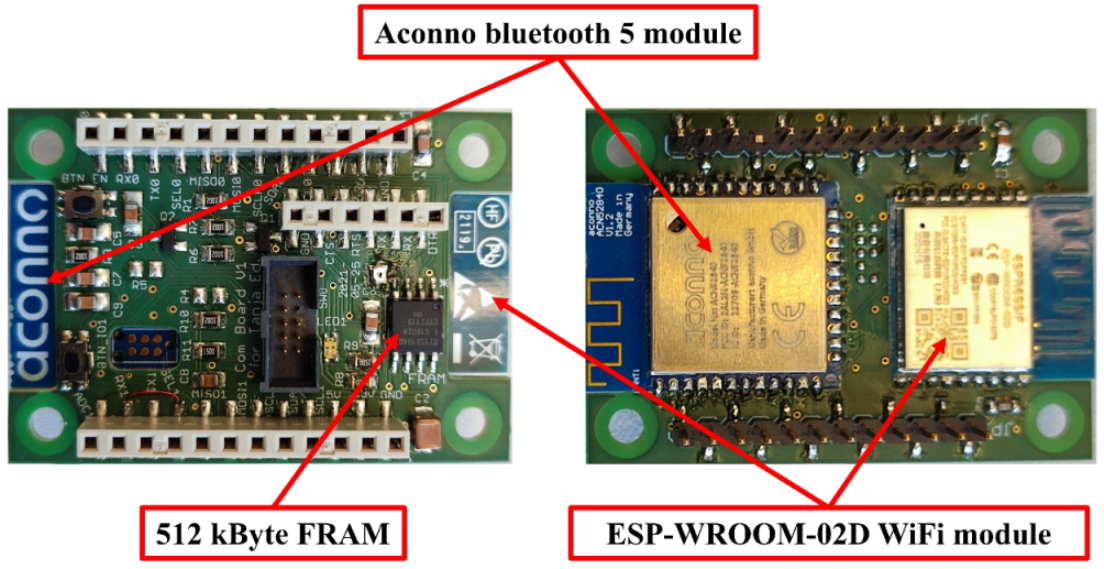
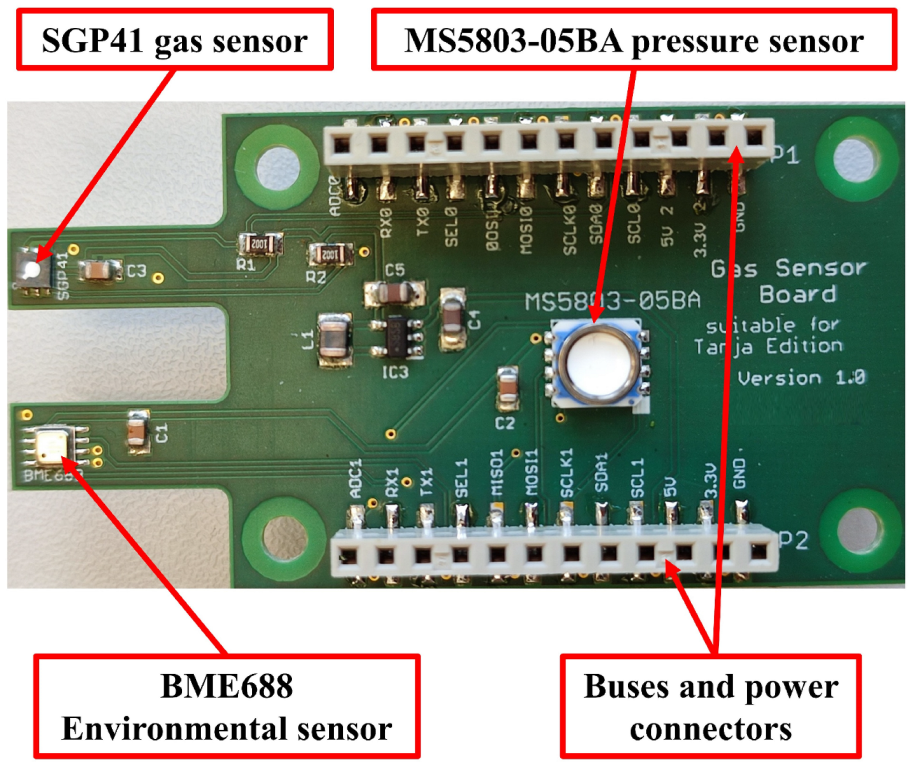
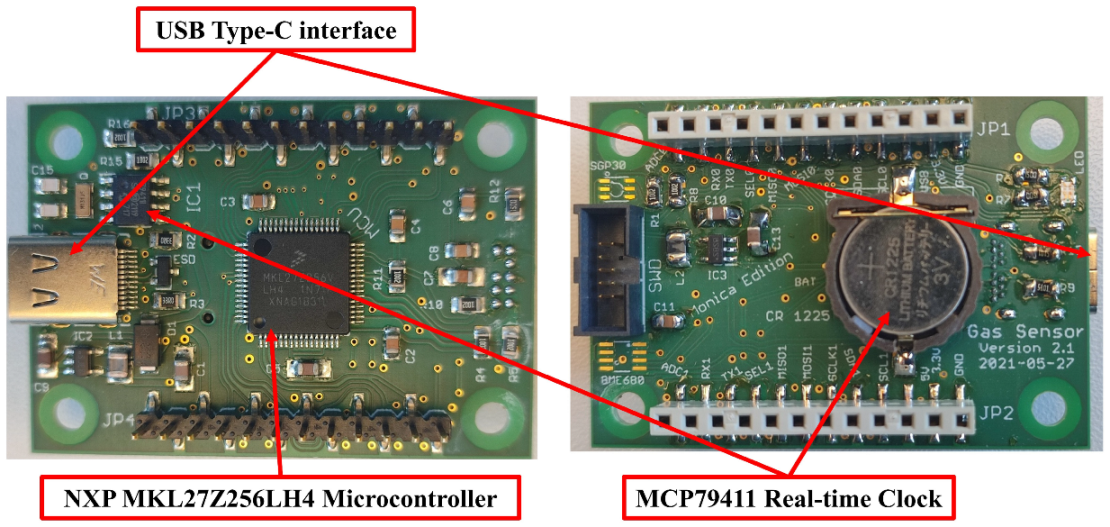
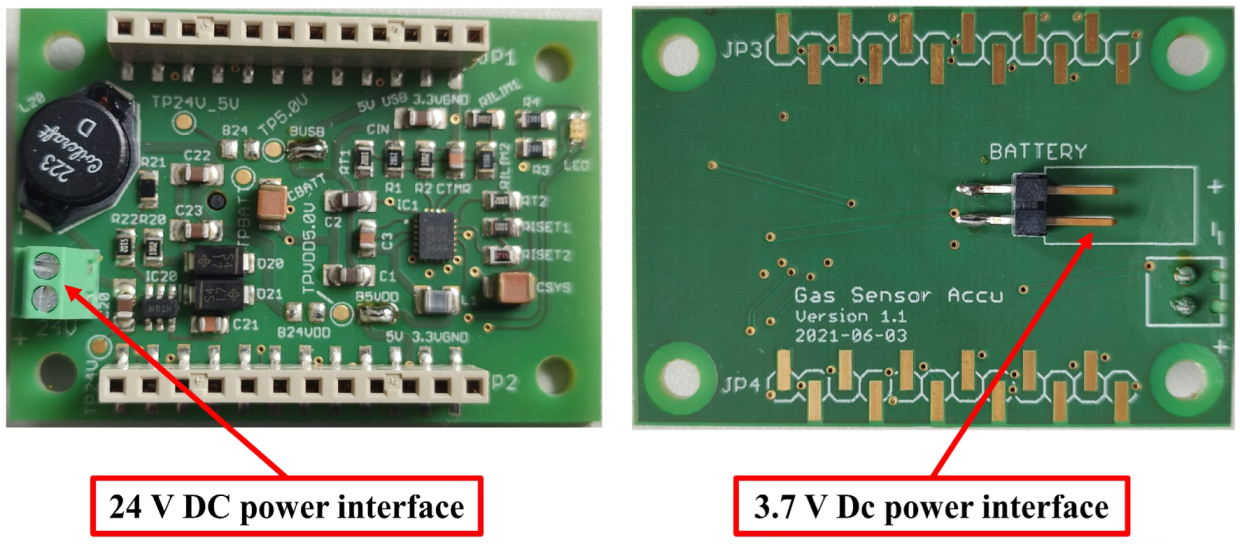
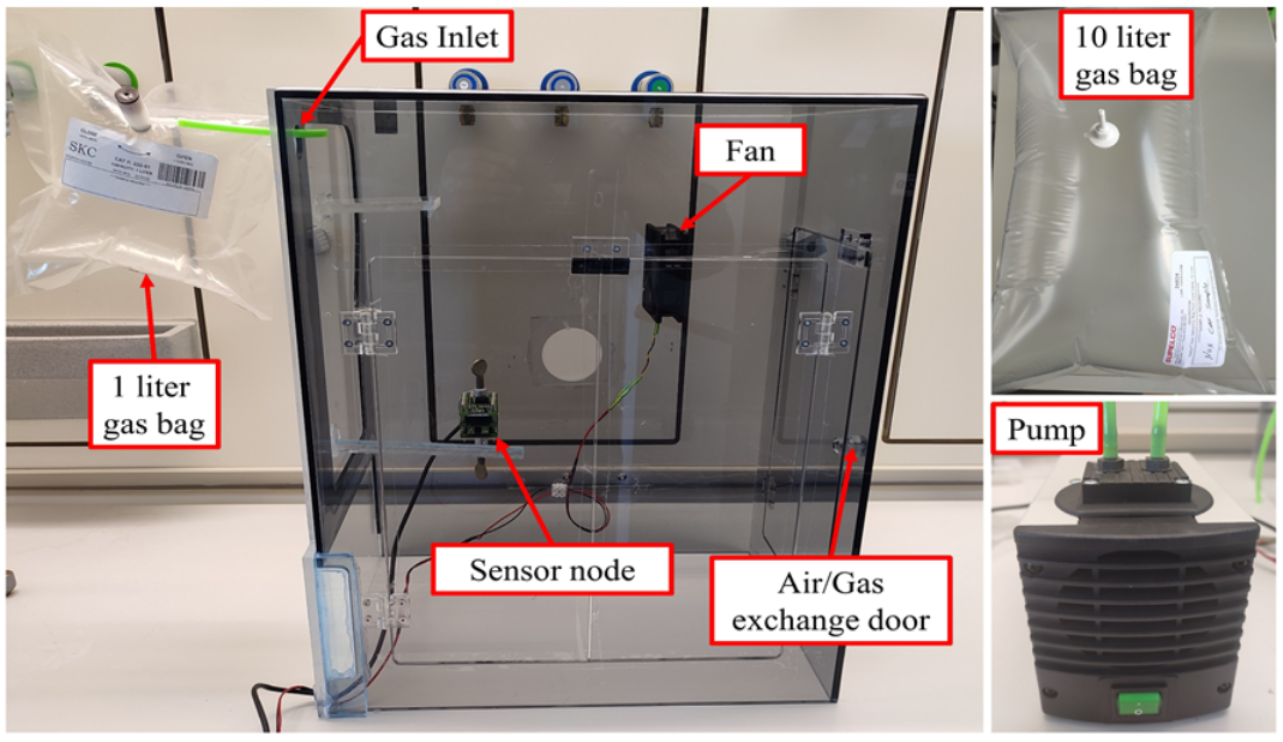





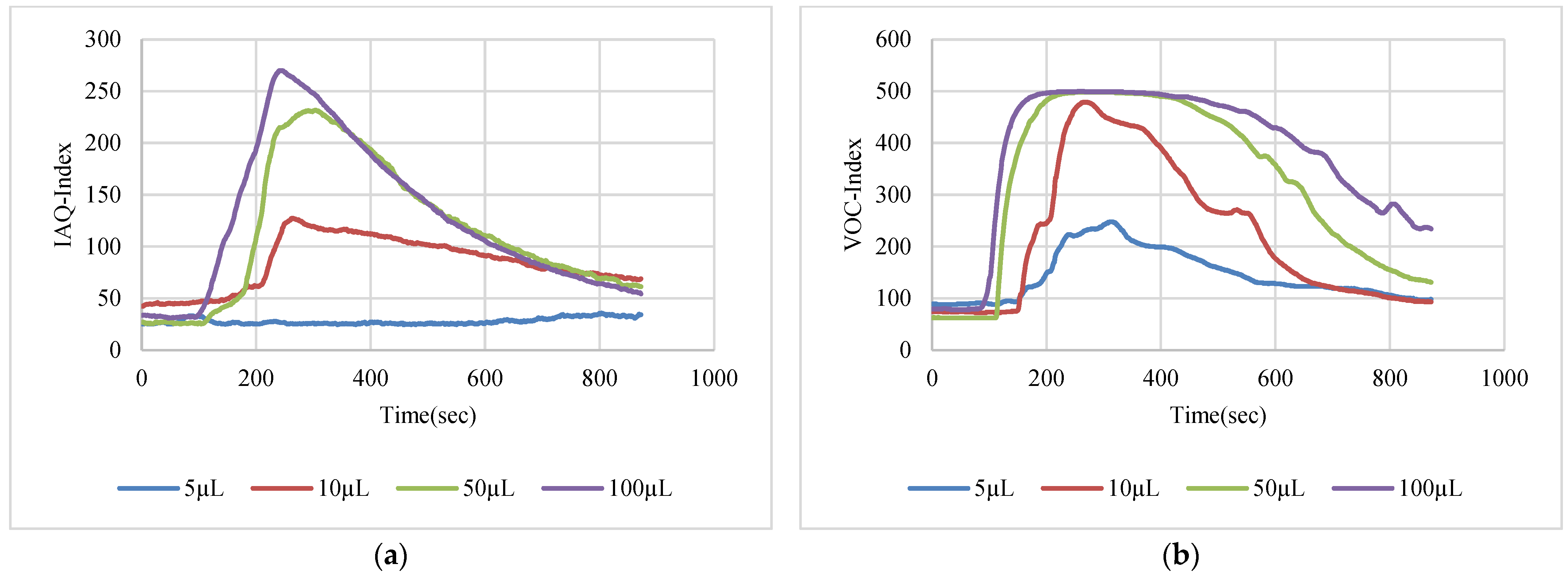


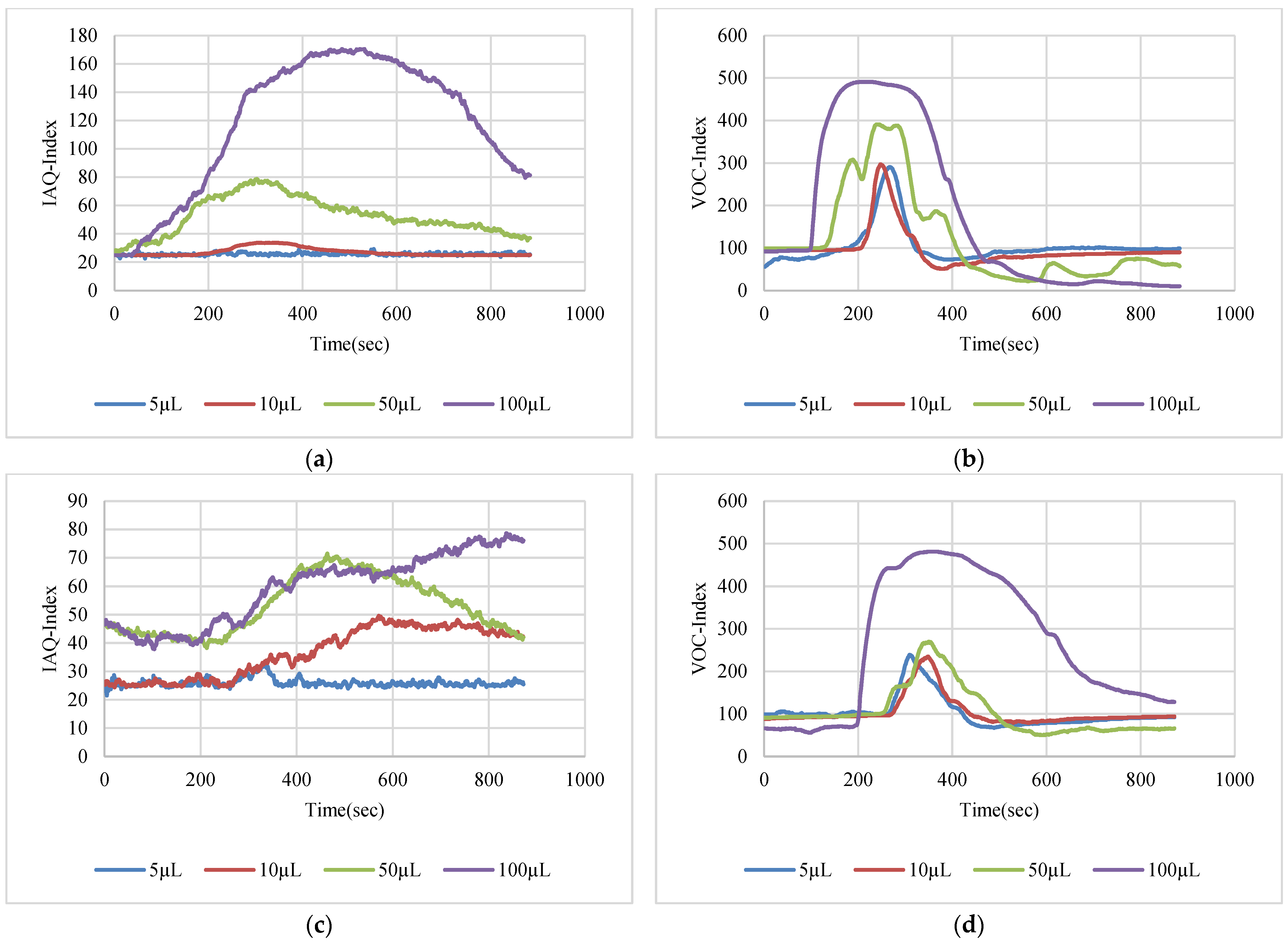
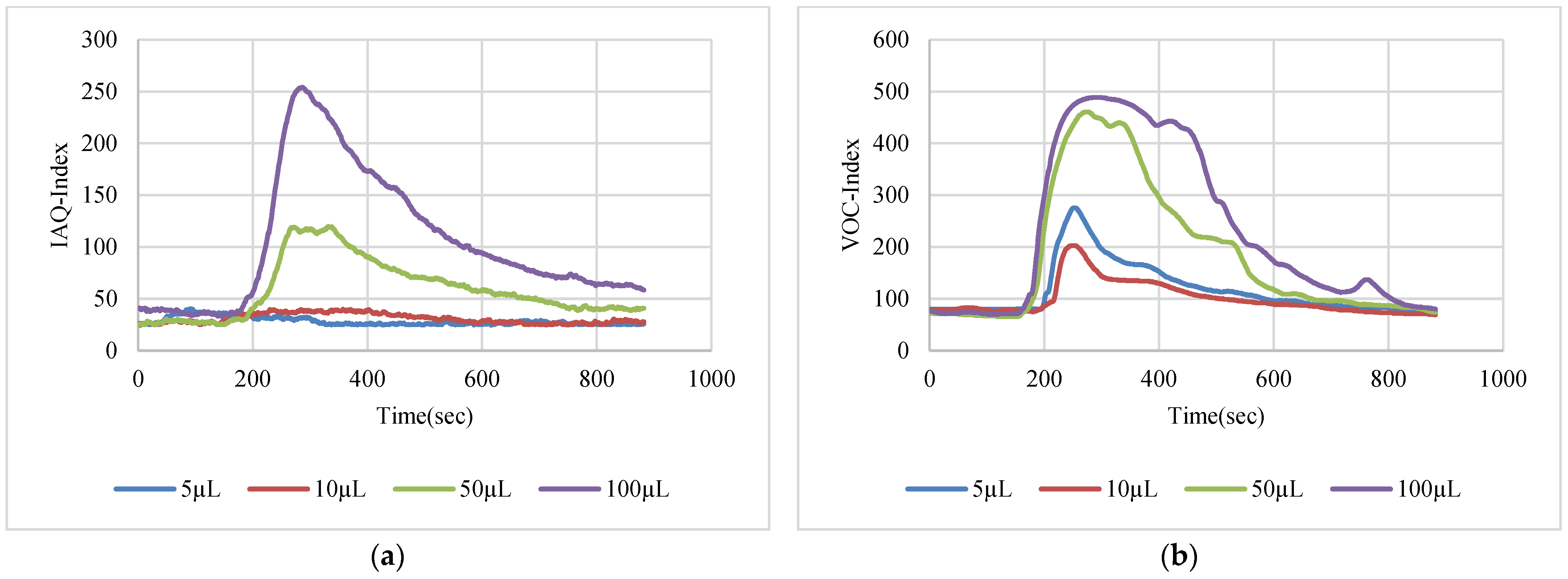
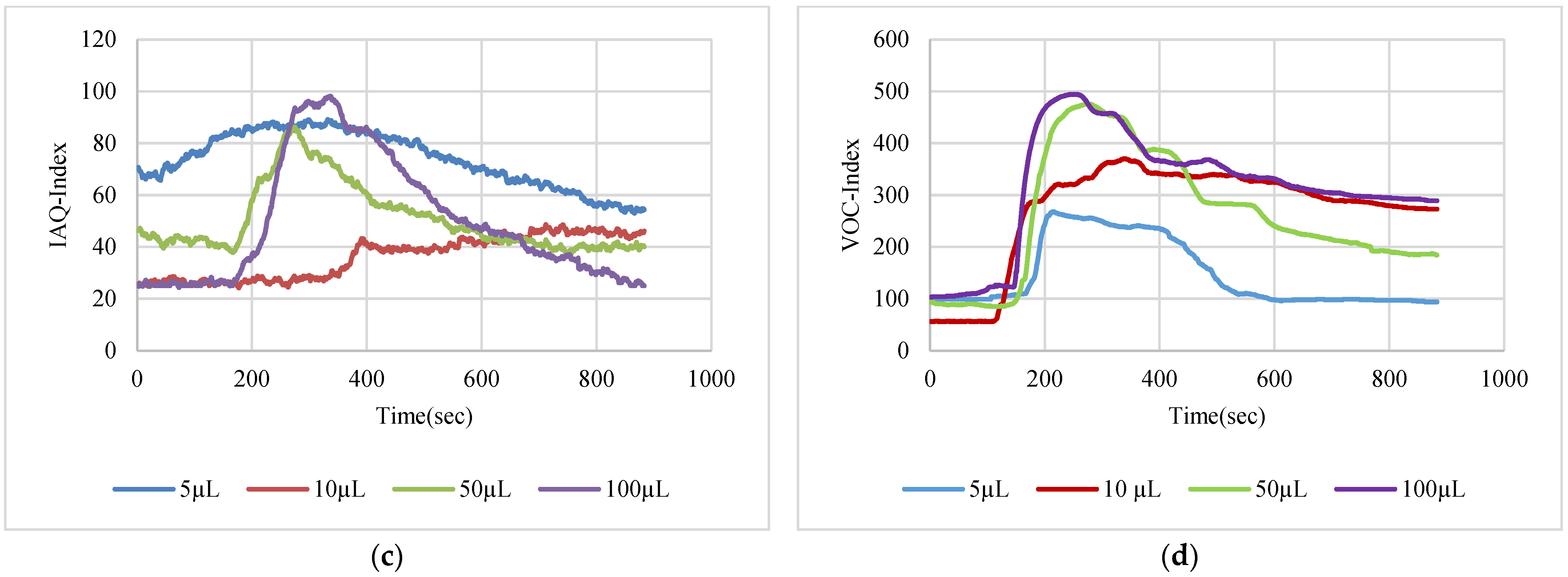
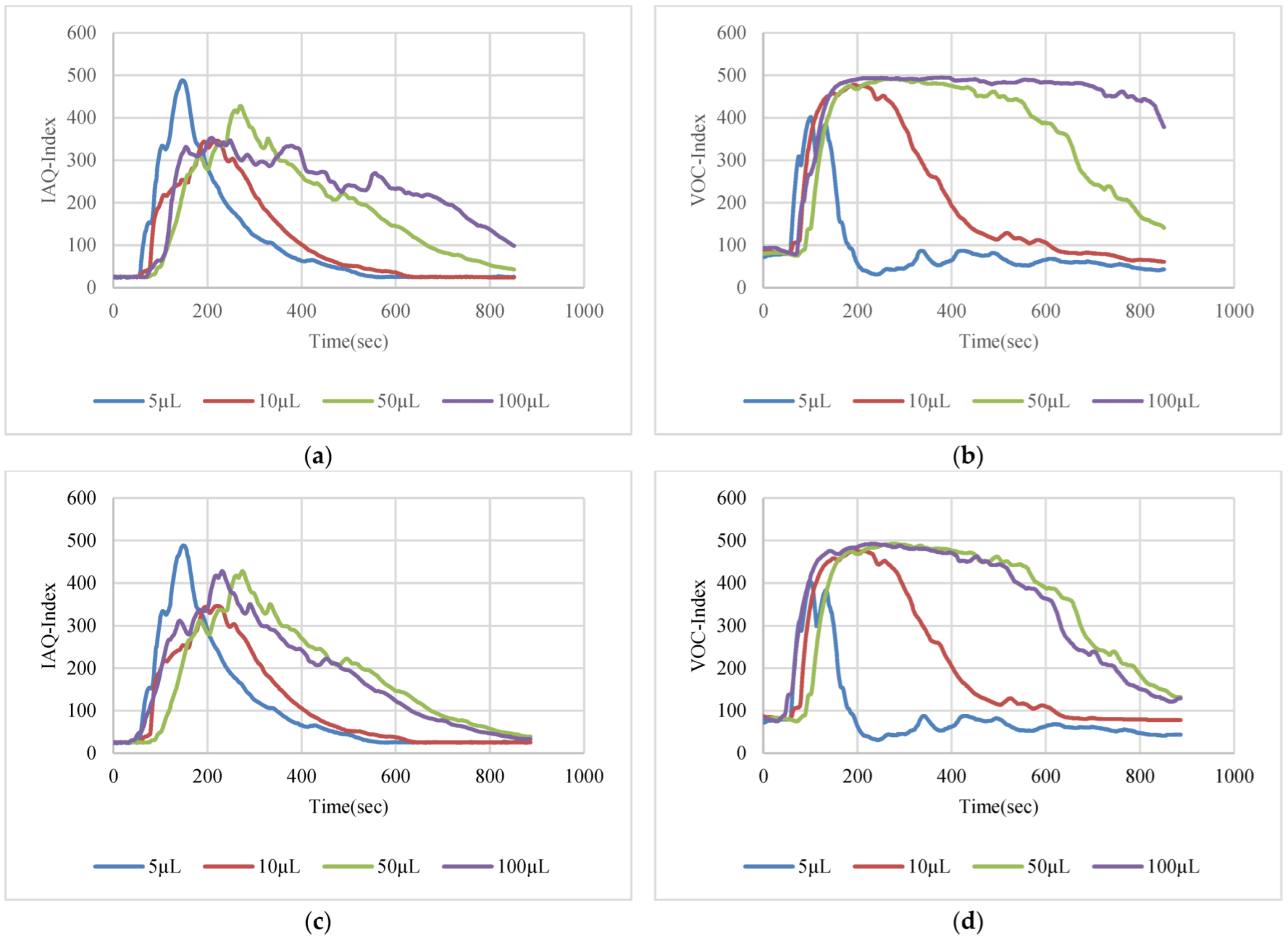
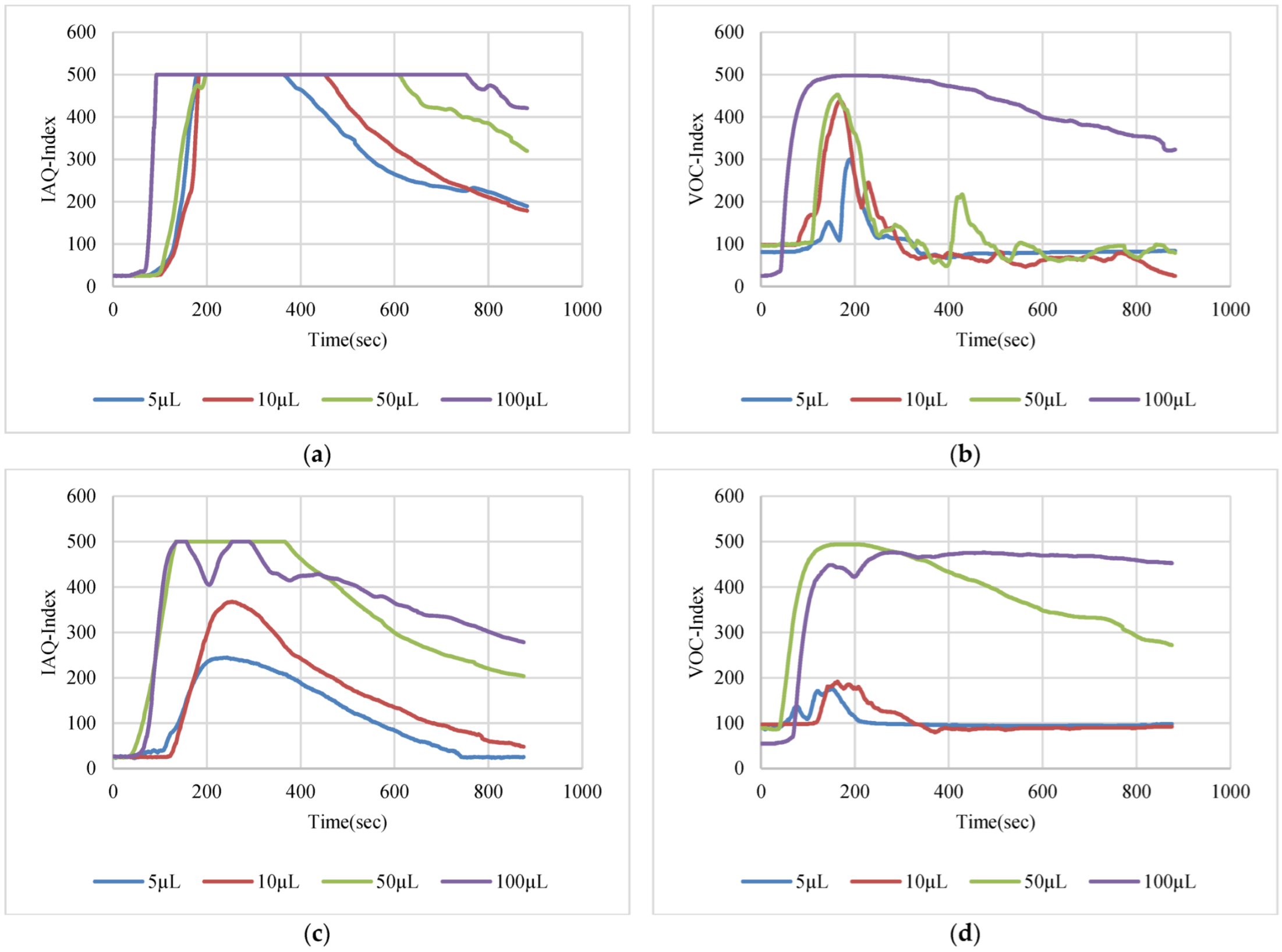
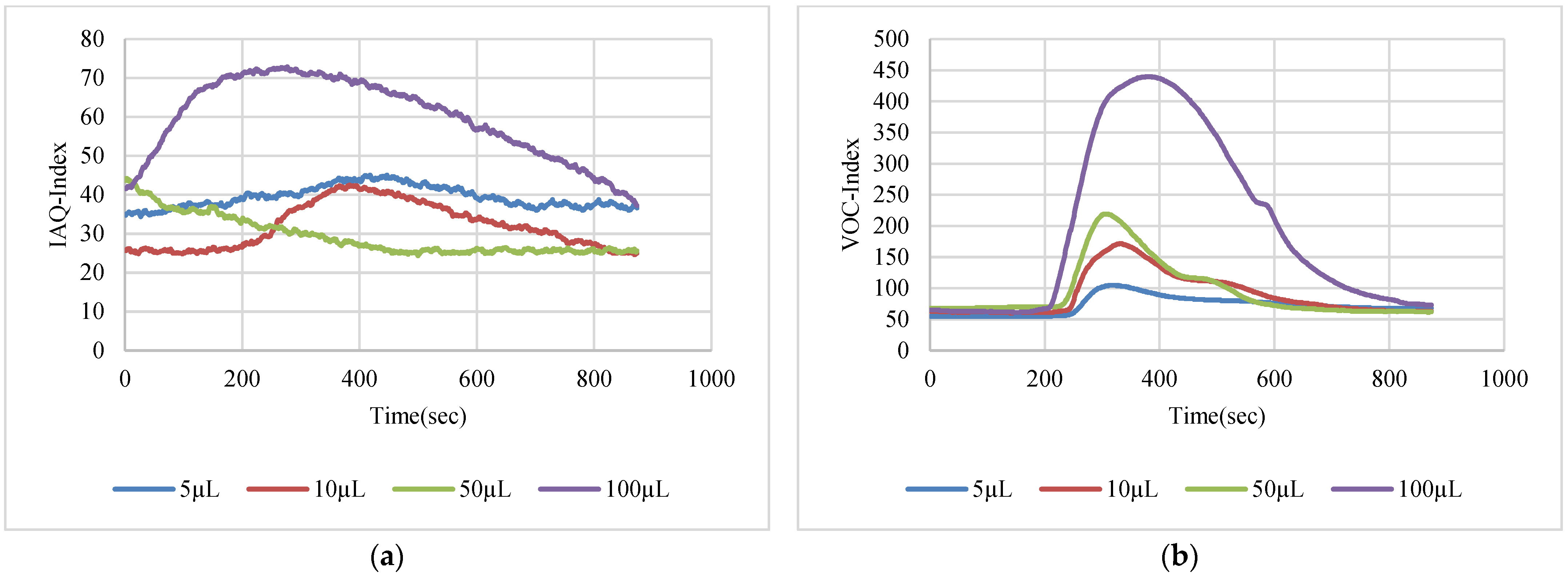
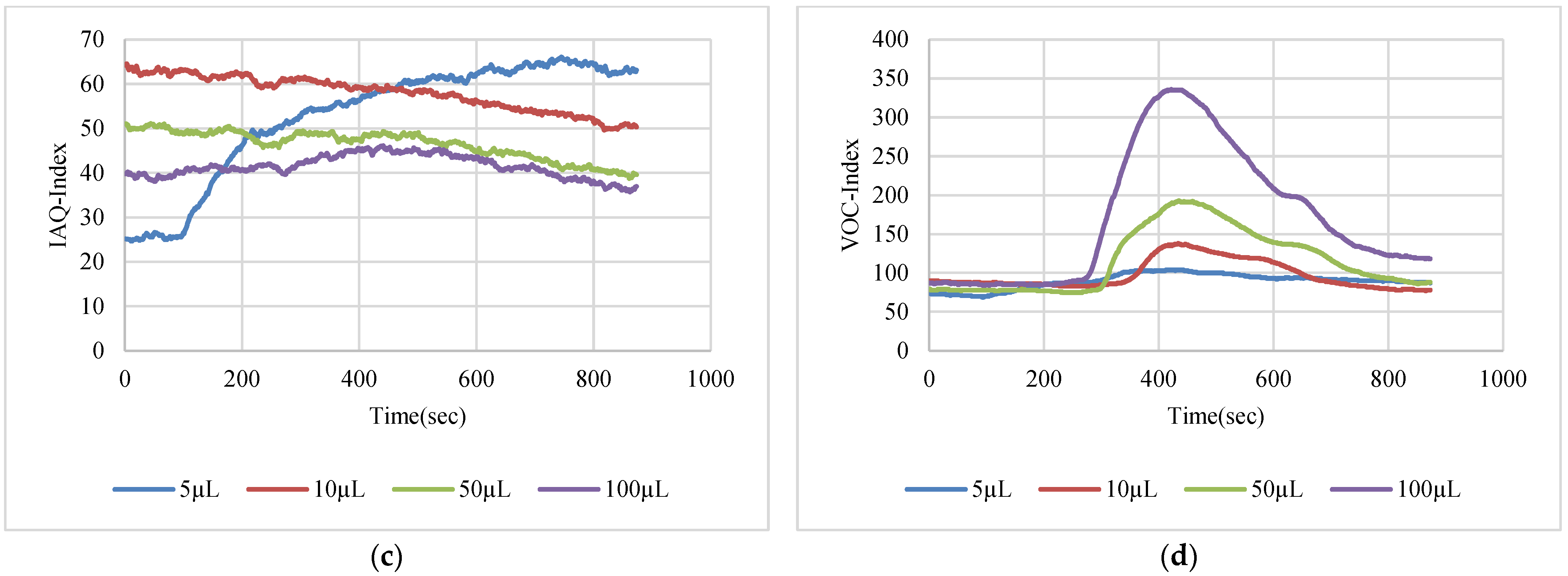
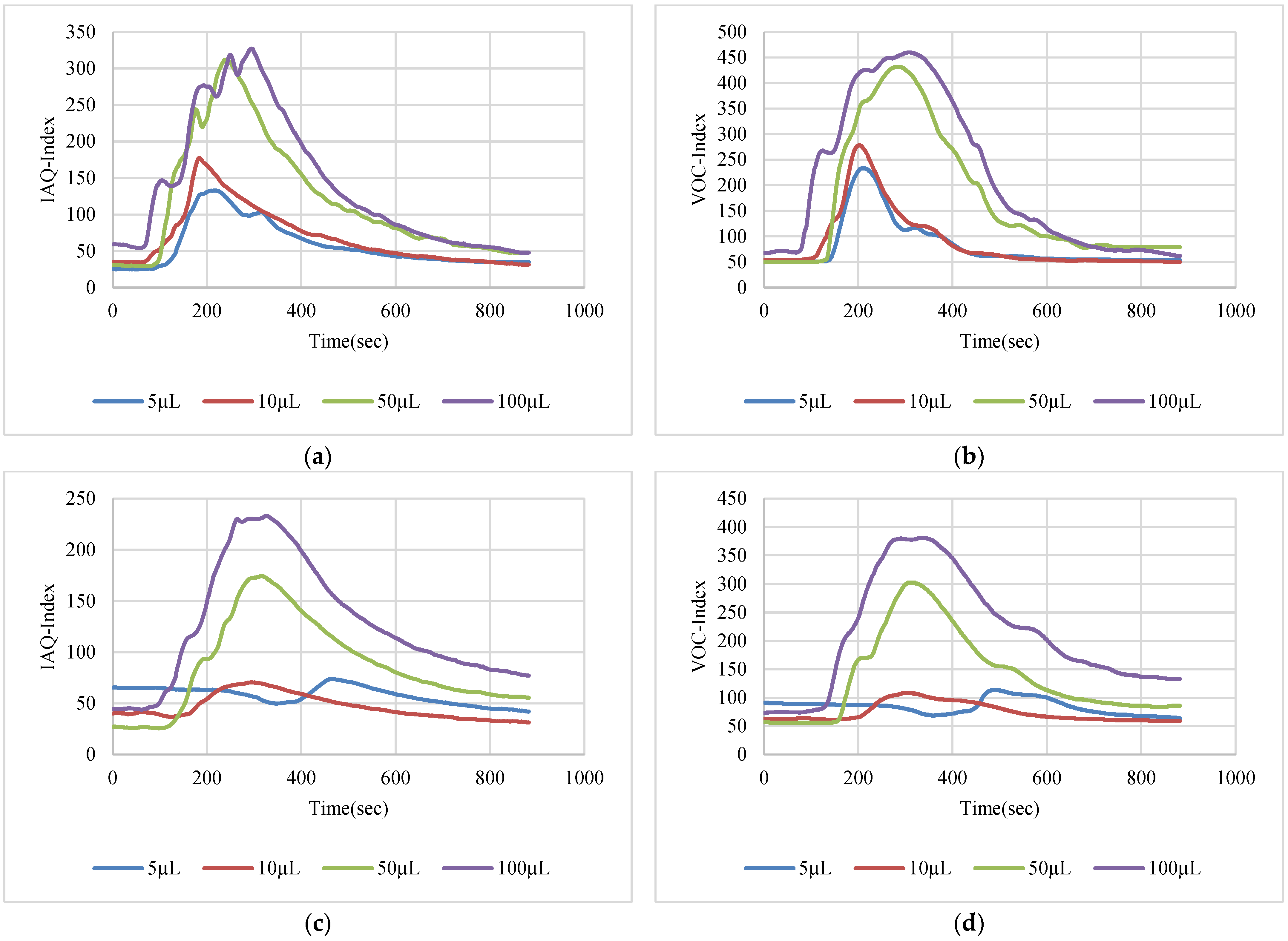




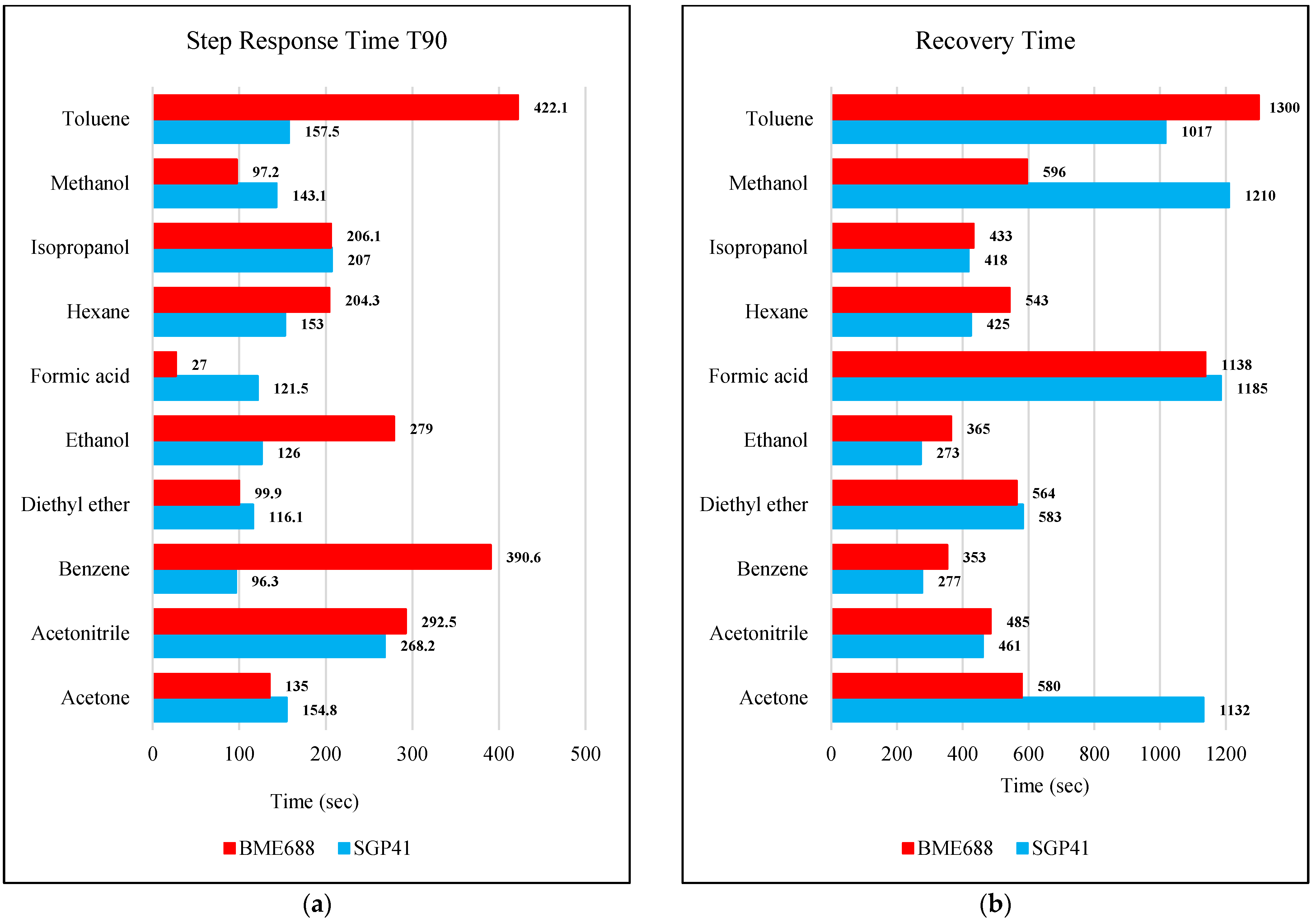
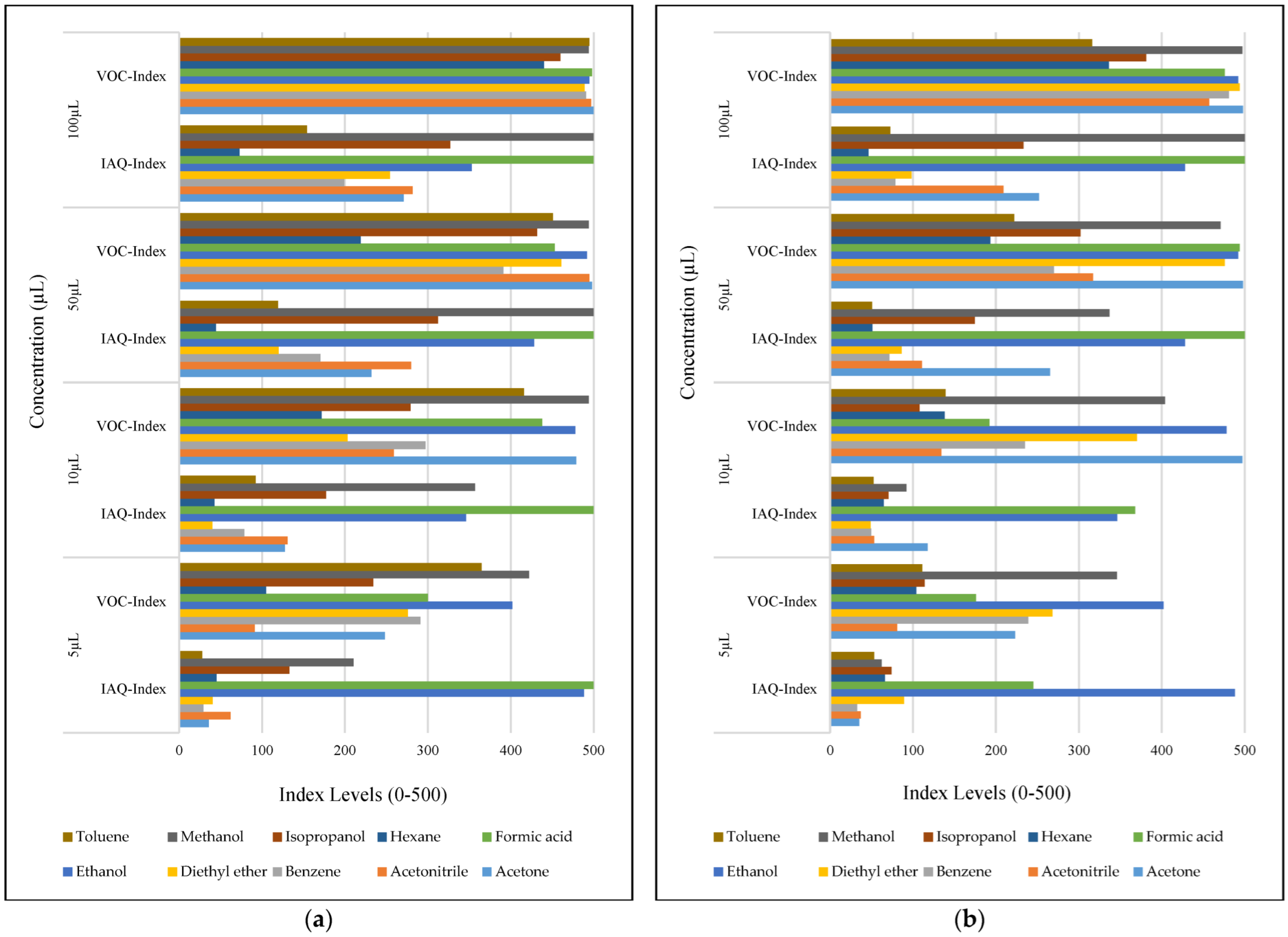
| VOC | SGP41 (40 cm) | SGP41 (100 cm) | BME688 (40 cm) | BME688 (100 cm) |
|---|---|---|---|---|
| Acetone | ≥5 μL | ≥5 μL | ≥50 μL | ≥50 μL |
| Acetonitrile | ≥10 μL | ≥50 μL | ≥50 μL | ≥100 μL |
| Benzene | ≥5 μL | ≥5 μL | ≥50 μL | - |
| Diethyl ether | ≥5 μL | ≥5 μL | ≥100 μL | - |
| Ethanol | ≥5 μL | ≥5 μL | ≥5 μL | ≥5 μL |
| Formic acid | ≥5 μL | ≥50 μL | ≥5 μL | ≥5 μL |
| Hexane | ≥50 μL | ≥100 μL | - | - |
| Isopropanol | ≥5 μL | ≥50 μL | ≥50 μL | ≥100 μL |
| Methanol | ≥5 μL | ≥5 μL | ≥5 μL | ≥5 μL |
| Toluene | ≥5 μL | ≥50 μL | - | - |
Publisher’s Note: MDPI stays neutral with regard to jurisdictional claims in published maps and institutional affiliations. |
© 2022 by the authors. Licensee MDPI, Basel, Switzerland. This article is an open access article distributed under the terms and conditions of the Creative Commons Attribution (CC BY) license (https://creativecommons.org/licenses/by/4.0/).
Share and Cite
Al-Okby, M.F.R.; Roddelkopf, T.; Fleischer, H.; Thurow, K. Evaluating a Novel Gas Sensor for Ambient Monitoring in Automated Life Science Laboratories. Sensors 2022, 22, 8161. https://doi.org/10.3390/s22218161
Al-Okby MFR, Roddelkopf T, Fleischer H, Thurow K. Evaluating a Novel Gas Sensor for Ambient Monitoring in Automated Life Science Laboratories. Sensors. 2022; 22(21):8161. https://doi.org/10.3390/s22218161
Chicago/Turabian StyleAl-Okby, Mohammed Faeik Ruzaij, Thomas Roddelkopf, Heidi Fleischer, and Kerstin Thurow. 2022. "Evaluating a Novel Gas Sensor for Ambient Monitoring in Automated Life Science Laboratories" Sensors 22, no. 21: 8161. https://doi.org/10.3390/s22218161
APA StyleAl-Okby, M. F. R., Roddelkopf, T., Fleischer, H., & Thurow, K. (2022). Evaluating a Novel Gas Sensor for Ambient Monitoring in Automated Life Science Laboratories. Sensors, 22(21), 8161. https://doi.org/10.3390/s22218161







